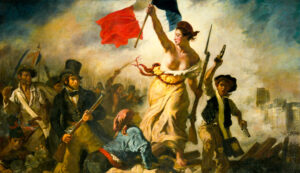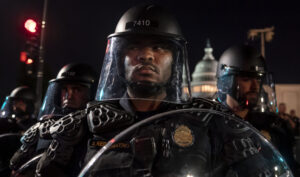If the contemporary political scene is strewn with wreckage, it is clearer than ever that “neoconservatism” and “neoliberalism” did much of the damage. More than any other, these two ideologies have afflicted both the centre-right and centre-left, fostering the sense of decay to which Margaret Thatcher’s insistence that “there is no such thing as society, only individual men and women, and families” has now led. The public sector was abandoned, as if individuals and families could make it on their own.
How did these two movements succeed in tearing up the fabric of Western society? Neoliberalism envisioned governance for the sake of individual and corporate enterprise, rolling back redistributive and regulatory policy in the name of “freedom”. Neoconservatism, meanwhile, though later more famous as a foreign-policy doctrine, was initially rooted in a scepticism towards domestic class and racial justice. Under the auspices of both schools of thought, the state was reconceived and morality was “restored” to the private sphere of “family values”.
No intellectual better embodied this peculiar fusion of neoliberalism and neoconservatism than the late historian Gertrude Himmelfarb, who died in 2019. Indeed, she was one of the most important and forgotten ideological pioneers of our times: an intellectual who did as much as her better-known husband, Irving Kristol, to invent the neoliberal-neoconservative complex.
Himmelfarb’s origin story is revelatory for two reasons. First, thanks to the central role Christianity played in her analysis (despite her Jewish background), her work serves as a challenge to those Christians belatedly joining the Left in attacking neoliberalism, and who do not appreciate how Christianity helped to cement neoliberalism’s position in the Republican Party in the first place. Second, even more importantly, Himmelfarb’s emphasis on religion forces secular liberals to re-examine their own participation in the Reagan revolution and its aftermath — the “Age of Reagan” has been one that later Democrats such as Bill Clinton and Barack Obama have been pleased to inhabit. For the unholy combination of neoliberalism and neoconservatism goes much further back than the Sixties, and into the era of Cold War liberalism in the Forties — since that is when Himmelfarb got her start.
Born in New York 1922 to Jewish immigrant parents, Himmelfarb studied at Brooklyn College before enrolling at the University of Chicago as a graduate student, having met Irving in 1940 at a meeting of the Young People’s Socialist League, a Trotskyist militant group they both frequented for a time in Brooklyn, where both hailed from. At Chicago, alone after her husband departed for service in Western Europe as an infantryman, Himmelfarb was drawn to the work of the 19th-century Anglo-German Catholic liberal Lord Acton — and ended up writing what became her first book on him, published in 1952. Her aim was to push back against the emergence of an optimistic and progressive liberalism that, she feared, shaded too easily into Leftism.
Acton, born in 1834, was a strange kind of liberal in his own lifetime, and only became a canonical figure in the middle of the 20th century. He was a Roman Catholic who resisted papal infallibility, his mind fixed on eternal moral certainties in an age that placed an emphasis on the evolving nature of liberal civilisation; he was suspicious of the nation state at a time when liberals treated it as their main instrument of progress; he even became sympathetic to socialism, at a time when liberalism so often took the form of economic libertarianism.
Amid the consolidation of the Cold War in the late Forties, as the world reckoned with a rising tide of totalitarianism, Acton’s adage about the corrupting power of absolute power assumed a new currency. No less than Friedrich Hayek, the godfather of neoliberalism, suggested to Himmelfarb, on a research trip in 1946 to England, that he was starting an Actonian club to resist the “totalitarianism” of the new planning state (which ultimately became the neoliberal Mont Pèlerin Society). For Himmelfarb, however, Acton’s revival initially served a very different purpose: to immunise liberals from dreaming big and instead recognise that politics is a scene of transgression rather than a forum of opportunity. By emphasising this, Himmelfarb helped define what later Cold War liberal Judith Shklar immortally dubbed “the liberalism of fear”, a replacement of the ambitious and optimistic liberalism of the 19th century with a more cautious, disabused and threat-oriented creed.
Like many other Cold War liberals, Himmelfarb had a particular (and mistaken) diagnosis of how liberalism could easily self-destruct. If liberals called for too much emancipation and progress, she thought, they would connive with evil forces to bring them about. They would, in other words, easily fall for the communist promise to achieve good things through immoral means. And if they neglected Christianity’s insight into the endurance of original sin, liberals would treat the state as a workable device of liberation and progress, rather than regarding it as a malignant expression of eternal depravity. The consequences, she warned, would be devastating, giving people who are tarnished by original sin the capacity to use state power to kill millions.
Though a Jew concerned about the abuse of minorities, Himmelfarb laid extraordinary emphasis on this point, in turn making Christianity integral to Cold War liberalism. While liberals had spent the prior century often viewing religious forces as an enemy, she called for a new liberalism based on Acton’s Christian vision of sin. Acton, who had rejected “integralist” forms of Christian Right-wing politics that longed for a return to medieval theocracy, was principally important for reforming secular liberals who sought to secure freedom against secular totalitarianisms such as Nazi and Soviet tyranny. He recognised, Himmelfarb wrote, “the presence of eternal and absolute” morality, in contrast to liberals who “had no sense of the religious sanctity of those principles” and compromised away freedom.
Indeed, it was liberal Christianity, Himmelfarb wrote, that might turn out to be essential in a Cold War world that knew the threat of religious authoritarianism even as secular revolution could bring even worse oppression. “Clerics are not alone in carrying the banner of religion,” she wrote. “They have been joined by a multitude of those who, in Acton’s own time, would almost certainly have been in the camp of the opposition.” Liberals needed to get over their anticlericalism, was the message, and use religion to save themselves.
It had to be the right kind of Christianity, of course. Acton was an Augustinian, and his vision of sin forbade excessive optimism. Humanity couldn’t save itself; man’s fallen nature made power a permanent threat. Instead, the Christianity useful for Cold War liberals saw God as the external judge on history, where the notion of secular progress supposedly leading to human emancipation was little more than an alibi for crime. For Acton, Himmelfarb explained, “history did not have a meaning or purpose in itself; it acquired meaning only by comparison with a fixed moral standard outside it, and purpose by fulfilling a moral end imposed upon it”.
This Augustinian core of Cold War liberalism is often conveniently forgotten. In an otherwise excellent recent book, for example, Louis Menand paints a portrait of Cold War liberalism as a utopia of innovative modernism, rather than one rooted in the religiosity that suffused the Forties and Fifties. One Cold War liberal icon, Oxford don Isaiah Berlin, divulged once in a letter to another such icon, American historian Arthur Schlesinger Jr., that he “had never read a line” of Lord Acton’s. Yet that did not stop Irving Kristol from crediting Berlin for “assuming the role of Lord Acton” as “conscience and critic” of believers in secular progress. And in spite of his own private reservations about a faith-based liberalism, Berlin understood that it defined the age of Cold War liberalism, writing in 1952 that “one of the most notable characteristics of the literary and artistic scenes” was “the revival of religion”, whatever its “pulverisation of… all the older forms of liberalism [and] secularism”.
Here is where Himmelfarb becomes representative of broader trends. Of all the Cold War liberals of this era — including Lionel Trilling, the Columbia English professor whom she and her husband lionised — Himmelfarb knew most about Judaism, though that was not saying much. For these Jews, ancestral preservation was hardly a powerful driving force — though there was a little more in Himmelfarb’s case because of her family’s observance of custom and ritual, and she took classes at the Jewish Theological Seminary while an undergraduate. For the most part, however, the identity politics of staying true to Judaism was not a significant motivation, compared to their very explicit appeal to Christian values to serve political goals. For Himmelfarb, Augustinian Christianity was a kind of ideological training ground for the intellectualism she conceived.
During the same period, Irving Kristol, schooled by his wife, also pursued a new religious orthodoxy, including a kind of neo-Actonian Judaism that rejected the optimism towards progress so prevalent among earlier liberals. Indeed, Kristol’s engagements with Christianity, with its emphasis on the permanence of sin, fed his epic denunciation, in January 1948, of modernising accounts of Judaism that presented it as a progressive social ethics rather than an acceptance of the strict limits that evil places on human possibility. This wasn’t because either Himmelfarb or her husband ever embraced observant Judaism, let alone converted to the Christian faith. It was because they believed Acton’s neo-orthodoxy was politically useful.
Both, in other words, fit well with Hannah Arendt’s quip that Orthodox Judaism was the Judaism that she didn’t practice. We can broaden her serious joke to the observation that, for a striking number of Cold War liberals like Himmelfarb and Kristol, Augustinian neo-orthodoxy was the Christianity they wanted everyone else to adopt. It would save them from the enthusiasm and naiveté of trust in the state.
Himmelfarb’s dalliance with Acton, and her Christianisation of liberalism, was fateful in the long run. It morphed, after all, into the successor views Himmelfarb soon adopted, neoconservatism and neoliberalism, with an emphasis on “family values” as the crucible of morality and the state as dangerous or fickle. Yet this wasn’t an immediate journey.
That Himmelfarb wasn’t immediately a neoconservative or neoliberal prepared to indict the welfare state in the name of Hayek’s market fundamentalism is made clear by two facts. First, in her early studies, she saw Acton as the great alternative to Edmund Burke, whereas Hayek saw them as equally inspirational. “When Liberals finally came to admit that Conservatism might be a store-house of political wisdom,” Himmelfarb complained as late as 1953, “they settled upon Burke as the arbiter of politics and morality. But the insights of Conservatism might have been more readily found in… an Acton, who set absolute morality against history.” Second, she registered that Acton’s liberalism could support social reform. Acton had come to insist that property was not absolutely sacrosanct even in a liberal state, and even repudiated — at his “most radical”, Himmelfarb said — the affection for laissez-faire economics of his youth. For a time, she outright rejected Hayek’s competing appropriation of their common sage.
Clearly, then, it would require a step beyond Cold War liberalism in a Christian key for Himmelfarb to reach her mature neoconservatism. While continuing to appeal to morality, she gave up her insistence on Acton’s liberal Christianity, even as she emphasised Christianity as a cultural force (and a source of many evangelical voters). By the Eighties, she was a crucial contributor to the intellectual destruction of the welfare ideals that were actually triumphing after the Second World War, while she was rifling through Acton’s writings. An activist state, she insisted, “consigns” the poor “to a culture of dependency and degrades those it professes to help”.
But everything — including the political movements Himmelfarb helped to rationalise, and which continue to warp the world — has to start somewhere. Easily the most consequential move in Himmelfarb’s evolution was her redefinition of liberalism in a Christian key, because it was only a short step from there to her mature views. If the trial of neoconservatism and neoliberalism continues in future years, Himmelfarb’s case suggests that the inquest will have to reach Cold War liberalism too.
Disclaimer
Some of the posts we share are controversial and we do not necessarily agree with them in the whole extend. Sometimes we agree with the content or part of it but we do not agree with the narration or language. Nevertheless we find them somehow interesting, valuable and/or informative or we share them, because we strongly believe in freedom of speech, free press and journalism. We strongly encourage you to have a critical approach to all the content, do your own research and analysis to build your own opinion.
We would be glad to have your feedback.
Source: UnHerd Read the original article here: https://unherd.com/




